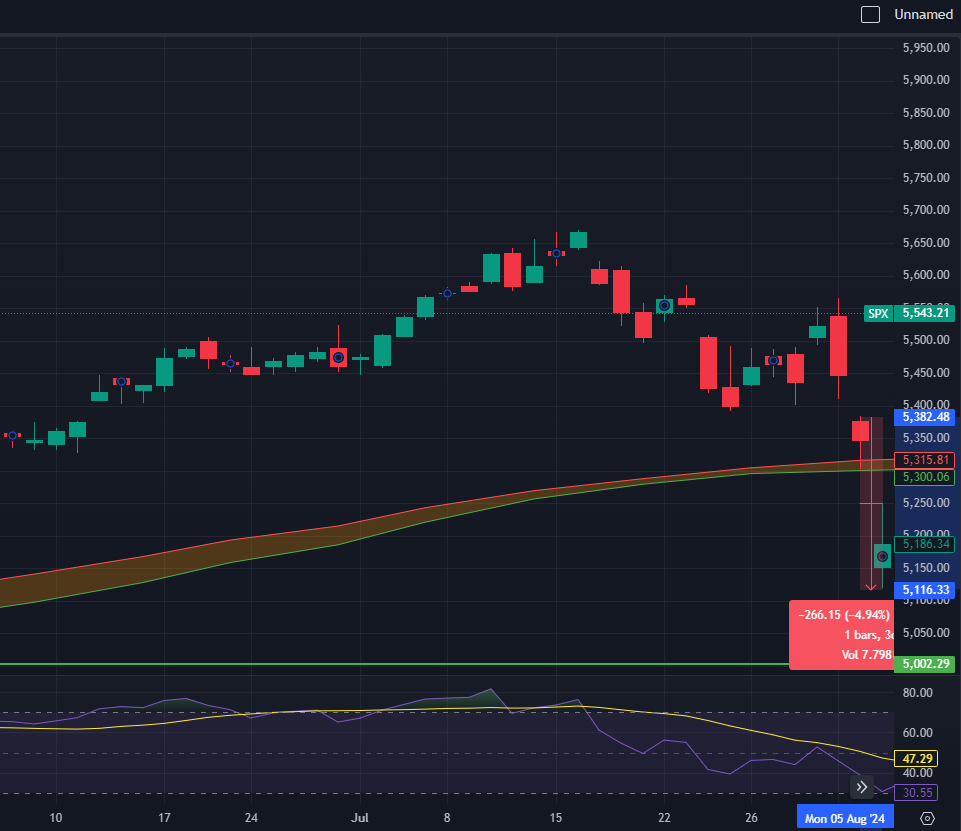Address
304 North Cardinal
St. Dorchester Center, MA 02124
Work Hours
Monday to Friday: 7AM - 7PM
Weekend: 10AM - 5PM
Address
304 North Cardinal
St. Dorchester Center, MA 02124
Work Hours
Monday to Friday: 7AM - 7PM
Weekend: 10AM - 5PM

The events that unfolded last Monday shook the market, here’s a detailed explanation of black Monday 2024 and the events that triggered the stock market selloff as well as some tips and future insights for what will (possibly) happen next.
Japan has been struggling economically since their 1995 crisis, inflation has been creeping on the Japanese consumer therefore the Bank of Japan decided to raise interest rates in order to ease inflation. The US Fed on the other hand decided not to raise interest rates (yet) what followed was disaster for the stock market…

As the Bank of Japan raised interest rates the Japanese Yen had an appreciation versus the US dollar. So what is the lesson here? That means that most of the time when the central bank of a different country other than the Fed raises interest rates and the Fed doesn’t, that country’s currency is going to appreciate against the US dollar.

This means that is you were say, a trader that borrowed some money from Japan in Yen you now have an 8% deficit against your dollar because of the dollar depreciation plus another big pickle: Your debt just increased by 25 basis points.
This is no joke, and most of the traders or investors that had overleveraged their investments using Japanese Yen had to sell their assets to cover their Japanese debt obligations thus triggering a selloff in the S&P500 and other indices we witnessed on Monday 5th of August 2024.
“Smart men go broke three ways – liquor, ladies and leverage.” – Charlie Munger
This is a very wise quote and something that investors must be wary of in case of leveraging investments using international loans and leverage.
Conversely, in theory, using this model, if the interest rate of let’s say Mexico’s central bank is lowered but the Fed remains steady, that would lead to a depreciation on the Mexican peso and an appreciation of the dollar vs that currency.

So what happens then if the fed lowers interest rates but the other central bank lowers it’s interest rate? The short answer: the dollar loses value. But that’s only one part of the puzzle and for what it’s worth, it may not always happen.
When both the Federal Reserve (Fed) and another country’s central bank, like Mexico’s, lower their interest rates, the effect on the exchange rate between the two currencies depends on the relative magnitude of the rate cuts and the overall economic context.
If the Fed and the Mexican central bank both lower their rates by similar amounts and under similar economic conditions, the exchange rate might not experience significant change because the relative attractiveness of holding assets in either currency hasn’t shifted drastically.
However, if one central bank cuts rates more aggressively than the other, or if the cuts are perceived differently by the market due to economic fundamentals or investor sentiment, then the currency of the country with the less aggressive cut may appreciate relative to the other.
Additionally, other factors like political stability, economic growth forecasts, and market liquidity also play crucial roles in determining how currency values adjust in response to changes in interest rates.
Let’s say then that the fed cuts interest rates and Mexico’s central bank cuts interest rates as well but does it more aggressively than the fed.
If the Federal Reserve (Fed) cuts interest rates, and the Banco de México (Banxico) cuts rates more aggressively, the Mexican Peso (MXN) is likely to depreciate against the U.S. Dollar (USD). This happens because more aggressive rate cuts in Mexico would generally make MXN-denominated assets yield less relative to USD-denominated assets, assuming other factors remain constant.
Investors typically seek higher returns, so they might move their capital to assets offering better returns. If U.S. assets offer higher yields due to less aggressive rate cuts, they become relatively more attractive. This increased demand for USD to purchase U.S. assets leads to appreciation of the USD against the MXN.
Moreover, aggressive rate cuts by Banxico could be interpreted as a sign of trying to stimulate a struggling economy or combat higher inflation rates, which might reduce investor confidence in the MXN further.
Using this knowledge then we can expect some depreciation in the Mexican peso and other currencies like the Canadian dollar. And while it’s not a given that these currencies will depreciate once the fed starts cutting interest rates in September (if they even decide to cut interest rates) we can have a fairly good understanding on where some if not most western forex pairs will go this September.
As a hedge therefore I am personally looking to hold my dollar denominated assets and sell some in the periods of late September to November and pherhaps even January once the volatility eases off.
We’ll see what will happen next but this is how I will personally play these next couple of months out once the fed switches it’s policy completely to QE.
The recent currency fluctuations highlighted by the appreciation of the Japanese Yen against the US Dollar following divergent monetary policies by the Bank of Japan and the Federal Reserve underscore the significant risks and opportunities in forex markets.
The events of Black Monday on August 6, 2024, serve as a stark reminder of the dangers of leverage in trading, especially when currency values can shift dramatically due to policy changes in major economies.
As central banks around the world adjust their interest rates in response to economic pressures, the resultant impact on currency values can be profound. Investors are advised to remain cautious, particularly with leveraged positions in international loans, as currency trends can swiftly reverse and lead to substantial financial losses. Looking ahead, the potential adjustments in Fed policy could further influence global forex dynamics, making it imperative for traders and investors to stay informed and adapt their strategies accordingly.
This scenario not only highlights the complexity of forex trading but also reinforces the need for prudent financial management and the avoidance of excessive leverage as advocated by financial wisdom like that of Charlie Munger.